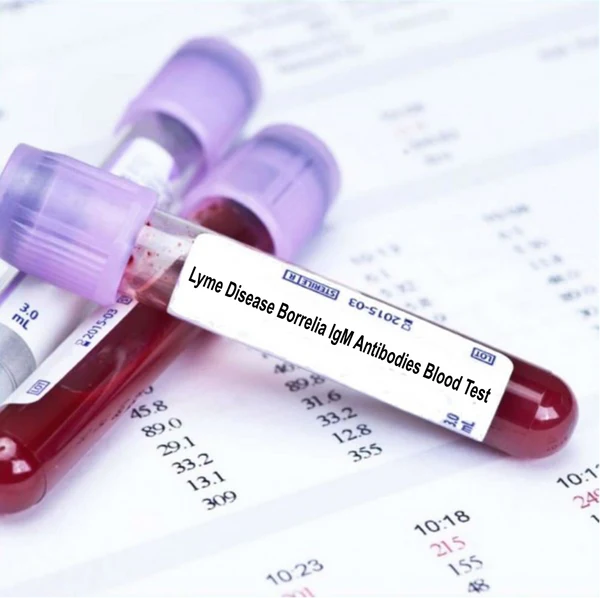The Lyme Disease antibodies blood test is used to detect antibodies produced by the immune system in response to infection with Borrelia burgdorferi, the bacterium that causes Lyme disease. This test helps diagnose Lyme disease and determine whether an individual has been exposed to the bacterium.
Overview of the Lyme Disease Antibodies Blood Test
What is Lyme Disease?
- Lyme Disease: An infectious disease caused by the bacterium Borrelia burgdorferi, transmitted to humans through the bite of infected black-legged ticks (also known as deer ticks).
- Symptoms: Early symptoms include fever, headache, fatigue, and a characteristic skin rash called erythema migrans. If untreated, infection can spread to joints, the heart, and the nervous system.
Why is the Lyme Disease Antibodies Blood Test Done?
The Lyme disease antibodies test is performed to:
- Diagnose Lyme Disease: Identify current or past infection with Borrelia burgdorferi.
- Confirm Clinical Diagnosis: Support a clinical diagnosis of Lyme disease in patients presenting with typical symptoms and possible exposure to ticks.
- Monitor Treatment: Evaluate the immune response to treatment for Lyme disease.
Types of Lyme Disease Antibodies
The Lyme disease antibodies test typically measures two types of antibodies:
- IgM Antibodies:
- Appear early in the infection (within 2-4 weeks).
- Indicative of an active or recent infection.
- IgG Antibodies:
- Develop later in the infection (usually within 4-6 weeks) and can persist for months or years.
- Indicative of a past or ongoing infection.
Two-Tier Testing Approach
The CDC recommends a two-tier testing approach for Lyme disease:
- First Tier – Enzyme Immunoassay (EIA) or Immunofluorescence Assay (IFA):
- Screens for antibodies to Borrelia burgdorferi.
- If the test is negative, no further testing is needed.
- If the test is positive or equivocal, the second tier test is performed.
- Second Tier – Western Blot:
- Confirms the presence of specific antibodies.
- For IgM, significant bands indicate recent infection.
- For IgG, significant bands indicate past or ongoing infection.
Test Procedure
- Preparation: No special preparation is typically needed for the Lyme disease antibodies test. However, it is important to inform your healthcare provider of any medications or supplements you are taking.
- Blood Sample: A blood sample is drawn from a vein in your arm.
- Laboratory Analysis: The sample is analyzed in a laboratory using EIA/IFA and, if needed, Western blot techniques to detect Lyme disease antibodies.
Interpreting Test Results
The results of the Lyme disease antibodies blood test are typically reported as positive or negative for IgM and IgG antibodies. Interpretation includes:
- Positive IgM and Positive IgG:
- Indicates an active or recent infection with Borrelia burgdorferi.
- Negative IgM and Positive IgG:
- Indicates a past infection with Borrelia burgdorferi.
- Negative IgM and Negative IgG:
- Indicates no evidence of infection with Borrelia burgdorferi. Early infection cannot be ruled out; follow-up testing may be needed if symptoms persist.
Factors Affecting Lyme Disease Antibodies Results
Several factors can influence the results of the Lyme disease antibodies test, including:
- Timing of Test: Antibodies may not be detectable in the early weeks of infection. Testing too soon after exposure can lead to false-negative results.
- Cross-Reactivity: Other infections or autoimmune diseases can cause cross-reactivity, leading to false-positive results.
- Immune Status: Immunocompromised individuals may have a delayed or diminished antibody response.
Follow-Up and Next Steps
If your Lyme disease antibodies test results indicate an active or recent infection, your healthcare provider may recommend:
- Antibiotic Treatment: A course of antibiotics to treat the infection, which can vary in duration depending on the stage and severity of the disease.
- Symptomatic Treatment: Managing symptoms such as pain, fever, and inflammation with appropriate medications.
- Monitoring: Regular follow-up to track the response to treatment and ensure the infection is fully resolved.
- Preventive Measures: Advising on ways to prevent tick bites, such as using insect repellent, wearing protective clothing, and checking for ticks after outdoor activities.
Benefits and Risks
- Benefits: Provides important information for diagnosing Lyme disease and guiding treatment decisions. Helps confirm clinical diagnosis and evaluate treatment response.
- Risks: The test is low-risk, involving a simple blood draw. Some individuals may experience minor discomfort or bruising at the puncture site. There is a risk of false-positive or false-negative results, especially if testing is done too early or late in the infection.
Conclusion
The Lyme Disease antibodies blood test is a valuable tool for diagnosing and managing Lyme disease. By detecting specific antibodies to Borrelia burgdorferi, this test helps healthcare providers confirm the presence of infection and guide appropriate treatment. Regular consultation with your healthcare provider is essential for interpreting test results and managing Lyme disease effectively.
Results – 2 days from Laboratory receiving sample







